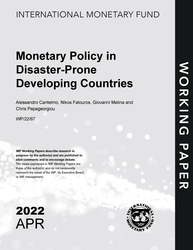
Monetary Policy in Disaster-Prone Developing Countries
Monetary Policy in Disaster-Prone Developing Countries
READ MORE...
Volume/Issue:
Volume 2022
Issue 067
Publication date: April 2022
ISBN: 9798400204371
$5.00
Add to Cart by clicking price of the language and format you'd like to purchase
Available Languages and Formats
| English |
Prices in red indicate formats that are not yet available but are forthcoming.
Topics covered in this book
This title contains information about the following subjects.
Click on a subject if you would like to see other titles with the same subjects.
Inflation , Economics- Macroeconomics , Money and Monetary Policy , Economics / General , Natural Disasters , Natural Disasters , Climate Change , DSGE , Monetary Policy , Exchange Rate Regimes , , monetary policy stance , inflation volatility , cases monetary policy , monetary policy response , analysis documentation , Inflation targeting , Inflation , Natural disasters , Monetary policy frameworks , Conventional peg , Caribbean
Summary
This paper analyzes monetary policy regimes in emerging and developing economies where climate-related natural disasters are major macroeconomic shocks. A narrative analysis of IMF reports published around the occurrence of natural disasters documents their impact on important macroeconomic variables and monetary policy responses. While countries with at least some degree of monetary policy independence typically react by tightening the monetary policy stance, in a sizable number of cases monetary policy was accommodated. Given the lack of consensus on best practices in these circumstances, a small open-economy New-Keynesian model with disaster shocks is leveraged to evaluate welfare under alternative monetary policy rules. Results suggest that responding to inflation to an extent sufficient to keep inflation expectations anchored, while allowing temporary deviations from its target is the welfare maximizing policy. Alternative regimes such as strict inflation targeting, exchange rate pegs, or Taylor rules explicitly responding to economic activity or the exchange rate would be welfare-detrimental.
Copyright © 2010 - 2025
Powered by:
AIDC



